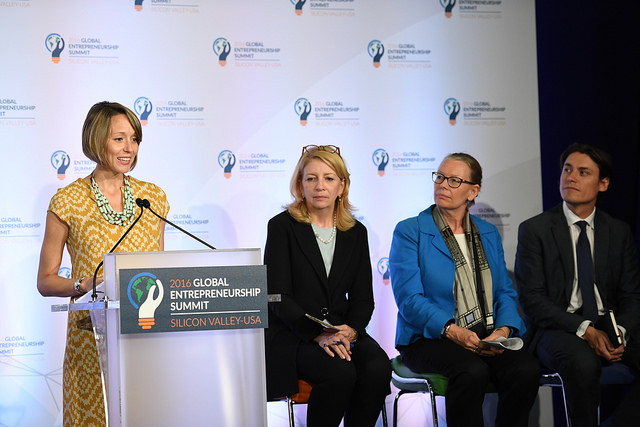Weekly Roundup is a McNair Center series compiling and summarizing the week’s most important Entrepreneurship and Innovation news.
Here is what you need to know about entrepreneurship this week:
Business Groups Hope Trump Can Change Health Law by Administrative Action
Jeffrey Sparshott, Reporter, The Wall Street Journal
Juanita Duggan, CEO of the National Federation of Independent Businesses, described the unraveling of the American Health Reform Act as “a dismal failure.”
Despite several nationwide organizations like the National Retail Federation, the U.S. Chamber of Commerce and the National Association of Manufacturers pushing lawmakers to support the plan, Republicans could not build a consensus for the bill.
Not all small business owners favored the GOP bill. According to Tom Embley, CEO of Precision AirConvey Corp., a Newark manufacturing company that employs 40 workers, the proposed plan wouldn’t have done “anything to lower costs” for his firm.
More Than Obamacare Repeal, Small Businesses Want Congress to Rein in Costs
Stacy Cowley, Reporter, The New York Times
The New York Times’ Cowley reports on health care reform as told from the perspective of small businesses. While small businesses have been some of the most outspoken critics of the ACA since its passage in in 2010, the group as a whole is actually fairly divided on the issue; according to Manta and BizBuySell, approximately 60 percent of small business owners want the ACA to be repealed.
As Cowley points out, “every business is uniquely affected by the complex law.” She spoke to small business owners across the country, representing a variety of regions and industries. Two themes were common: The lack of sustainability of the status quo and the need for bipartisan reform. One thing Congress’s recent health care drama did accomplish was to reveal small businesses’ growing disdain for Congress’s inability to find common ground and deliver policy stability.
Early-Stage Investment for Software Startups Holds Steady
Alex Wilhelm, Editor In Chief, Crunchbase News
A recent Crunchbase report reviews the performance of younger SaaS companies after a year of relatively illiquid market for late-stage SaaS startups in 2016.
SaaS, or software as a service, refers to “firms that sell software products on a recurring basis.” As Wilhelm notes, SaaS firms constitute an “important part of the modern startup landscape.” According to Crunchbase analysis, early and mid-stage SaaS startups experienced relatively tame Series A and B funding rounds last year, despite the sector as a whole putting on a poor showing for enterprise IPOs when compared to 2015.
Wilhelm suggests that the better-than-expected fundraising aggregates indicate investor confidence that “the late-stage and public markets would figure out SaaS, or a blind willingness to follow a plan that was supposed to work.”
Kushner to Oversee Office of American Innovation at White House
Michael C. Bender, Reporter, The Wall Street Journal
President Trump recently announced the opening of a new White House office, the Office of American Innovation (OAI). The new White House office, tasked with mimicking “private-sector efficiency inside the federal government,” will be led by Jared Kusher, senior policy advisor and son-in-law to President Trump. The office will oversee a number of ambitious task forces, including the taskforce that will be headed by Governor Chris Christie to address the opioid epidemic.
According to Press Secretary, the OAI will address both long-term and urgent needs, such as” modernizing information technology” and “streamlining the Department of Veteran Affairs.” Additionally, the office will conduct communications with many executives, including prominent Silicon Valley CEOs who visited the White House in recent months.
Ask a Female Engineer: How Can Managers Help Retain Technical Women on Their Team?
Cadran Cowansage, software engineer at Y Combinator Blog
Y Combinator’s Cowansage attempts to understand why women tend to step out of technical positions more frequently than their male counterparts. Cowansage asked several female engineers about their past decisions to leave their technical position at a specific company or the industry entirely. Interestingly, many of the responses don’t specifically address gender-driven workplace conflicts or discrimination. Instead, many of the women attribute their departures to irreconcilable differences with company management.
Startups often lack formal HR departments. Impartial organizational roles, like senior HR employees, who are distanced from the executive team are valuable resources; these positions offer employees an outlet for voicing their complaints without fear of jeopardizing their job status. Additionally, many women left their previous engineering positions due to lack of shareholder attention to the project they were dedicated to. Another commonly voiced problem during the interviews was rejection of requests for a promotion or raise. The interviews revealed that many women were willing to leave their company when they learned that employees with less experience were earning higher salaries or bonuses.
Startups Increasingly Turning to Debt Financing Despite Dangers
Mikey Tom, Reporter, PitchBook
PitchBook’s Tom shares some insight from 2016 Annual VC Valuations Report. According to the report, median early-stage valuations and the tally of firms that exited the market at a lower valuation than their most recent valuation reached an all-time high. As Tom points out, “rather than raising a new equity round at a sub-optimal valuation or seeking a premature liquidity event,” startups are increasingly relying on debt financing for cash. In fact, excluding 2016, the number of startups composed of debt has increased since 2008. Notably, many of the massive tech unicorns, like Airbnb and Uber, raised billion dollar loans in recent years.
Tom acknowledges the attractiveness of debt financing for many startups, but he forewarns founders of the dangers of accumulating too much debt: “if a startup is unable to achieve the amount of growth it forecasts, the debt ends up acting as more of a time bomb than growth equity.”




